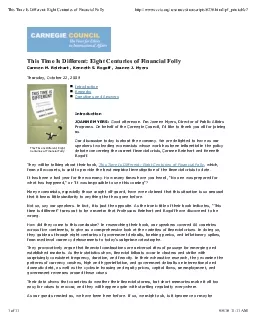

Thank you very mucheis a lot of other debt that you owe to your own citizenspension funds rich individuals In fact one thingwe discovered is that its the same order of magnitudeWe could go off on a lo ID: 883015
Download Pdf The PPT/PDF document "large currentaccount deficits We were im..." is the property of its rightful owner. Permission is granted to download and print the materials on this web site for personal, non-commercial use only, and to display it on your personal computer provided you do not modify the materials and that you retain all copyright notices contained in the materials. By downloading content from our website, you accept the terms of this agreement.
1 large current-account deficits. We were
large current-account deficits. We were importing a lot of capital from abroad. We were borrowing fromthe rest of the world. Thank you very much. ,eis a lot of other debt that you owe to your own citizensÑpension funds, rich i
2 ndividuals. In fact, one thingwe discove
ndividuals. In fact, one thingwe discovered is that it's the same order of magnitude.We could go off on a long tangent about that, but there are things that it's just criminal that they don'texist. I don't think it's an accide
3 nt that the government debt data is hard
nt that the government debt data is hard to get. I thinkÑI'm not beingfacetiousÑthey don't want us to have this.Here we were at the IMF, working on Argentina, working on Brazil. Are they in trouble or not? We onlyhad what they
4 owed to foreigners, looking at historic
owed to foreigners, looking at historical benchmarks. We could only look at that forsustainability exercises.Anyway, there are other things in the data set. But having this data let us say things that nobody had on, we should
5 have been suspicious.There's a whole po
have been suspicious.There's a whole political economy element to this that we talk about but don't go into too deeply. Surelythere is a dynamic that some sectorÑin our case, it was the financial sector; other times, it's the
6 corporate sector or othersÑgets rich in
corporate sector or othersÑgets rich in this process, and that helps them support the dynamic politic debts, and it complicates it. So it ought to get taken over by the Treasury and then worked out over avery long period. Inst
7 ead, it's in the wrong placeÑthe Federal
ead, it's in the wrong placeÑthe Federal ReserveÑbecause Congress wouldn't doanything in the crisis. That forced the Fed to bear this burden. At least that's my interpretation.CARMEN REINHART: A lot of the unwinding is just by
8 allowing maturities to expire.KEN ROGOF
allowing maturities to expire.KEN ROGOFF: Which could take a long time.QUESTION: Not focusing so much on quantitative easing and how you try and mitigate or deal with theeffects of a crisis, but talking more about how to aver
9 t a crisis, in your historical research,
t a crisis, in your historical research, have you comeacross many examples of cases where governments or regulators successfully averted a crisis that wouldotherwise have been building up? If you did, is it your view, based on
10 that research, that you are morelikely
that research, that you are morelikely to be successful doing it by addressing capital imbalances or by dealing with it on the regulatoryendÑi.e., by curbing the excesses that tend to occur when the capital imbalances build u
11 p?CARMEN REINHART: I am actually going t
p?CARMEN REINHART: I am actually going to give one concrete example, but you can only draw so manylessons. One country that actually had its last crisis very vivid in policymakers' minds is Chile in part of households as well